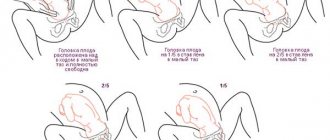The benefits of an enema before childbirth
Several decades ago, an enema was a strictly mandatory procedure before childbirth.
In recent years, more and more alternative views on this preparatory event have emerged. Advantages of an enema before labor begins:
- removal of feces from the intestines is disinfecting in nature, significantly reducing the risk of infection of the child during childbirth;
- an enema eliminates the possibility of spontaneous bowel movements during childbirth;
- in the postpartum period, the risk of divergence of internal and external seams when going to the toilet is reduced;
- the absence of feces in the intestines of a woman in labor facilitates the process of the baby moving through the birth canal and reduces the risk of injury;
- cleansing the intestines stimulates the onset of active contractions, the contractile activity of the uterus increases and labor proceeds faster.
These undoubted advantages are a strong argument in favor of carrying out this procedure before childbirth.
Why are some doctors against enemas?
Why did foreign clinics and some of our maternity hospitals refuse to give enemas to women in labor? This is explained as follows:
Recently, after a number of American studies, it has been proven that an enema does not affect the acceleration of labor as was previously believed.- Even after a well-done enema, during pushing, liquefied feces may be released from the rectum. Midwives are increasingly inclined to believe that it is better to have a single full bowel movement than unpleasant watery splashes after an enema, which are much more difficult to remove.
- In any case, defecation occurs before the baby’s head cuts through, so you should not be afraid of feces coming into contact with the baby’s skin - this is unlikely.
- Modern trends are such that more and more specialists adhere to the management of childbirth in conditions close to natural. But the enema was not intended by nature! During the normal course of labor, during labor, bowel movements occur naturally, often even several times, so that by the time the bowel is pushed, the intestines are clean and without an enema. Even if trouble does occur on the maternity table, you shouldn’t worry about it, since the whole thing goes into a special tray and is removed instantly, and no one pays attention to it.
According to the latest data from American studies, an enema does not affect the duration of labor, as previously thought.
Midwives believe that it is better not to opt for an enema, because no matter how well it is administered, in the process of pushing, liquid masses are still released from the rectum. Therefore, it is easier to help a woman in labor empty herself once than to constantly remove watery splashes after an enema.
Doctors believe that doing an enema at home can even be dangerous for a woman in labor if she has not consulted her gynecologist first. Every expectant mother should know that an enema is contraindicated if there is a threat of uterine rupture, prolapse of umbilical cord loops, placental abruption, or fetal hypoxia.
There are many ways to cleanse the intestines before childbirth. But you should understand that frequent use of laxatives in cases of constipation will cause addiction to the drugs, and this will result in health problems in the future.
We should also not forget that the right to decide whether or not to agree to an enema remains with the woman in labor, and no one has the right to force her. The exception is the need for an enema at the insistence of a doctor based on medical indicators.
In what cases should it not be used?
Even such a simple procedure as an enema has a number of contraindications for its implementation. These include:
- the presence of inflamed hemorrhoidal cones in and around the anus;
- intestinal dysbiosis and any disorders of the intestinal microflora;
- mechanical damage and intestinal surgery;
- A woman has loose stools for a long time.
An enema is a fairly aggressive intervention in the functioning of the intestines.
First of all, the microflora suffers. Therefore, the procedure is contraindicated for women who are prone to bowel movements.
If you have hemorrhoids, doing an enema is also not recommended, because... inflamed nodes can be damaged.
Therefore, a woman should first consult a doctor and find out how to cleanse the intestines before giving birth.
When and how to put
To rid yourself of unnecessary doubts, you should study information about how an enema is done in the maternity hospital.
The procedure for cleansing the intestines of a woman in labor is carried out in the first stages of labor. To introduce liquid into the anus, a special device is used - an Esmarch mug.
It is a container made of rubber with a capacity of 2 liters. The mug is filled with water. Its temperature should not exceed 37 degrees.
The woman is placed on her side on the couch. The tip of Esmarch's mug is treated with Vaseline and inserted into the woman's anus. The fluid is introduced gradually and slowly. The woman is advised to relax.
After all the water from Esmarch's mug has entered the intestines, the woman is sent to the toilet. After cleansing the intestines, you need to take a shower and go to the prenatal ward for examination.
Is it possible to give an enema at home and how to do it?
The colon cleansing procedure is very intimate and makes many women feel awkward. Therefore, expectant mothers often ask: “Is it possible to do an enema before childbirth at home?”
It is possible to carry out this procedure in more comfortable conditions. To do this you need:
- purchase an Esmarch mug at the pharmacy;
- Be sure to treat the enema tip with Vaseline; this procedure should also be carried out with the anus;
- carefully prepare the place where the woman will be at the time of administration of the liquid, lay down oilcloths.
If you prepare for the procedure correctly, doing it at home will be quite simple.
Upon arrival at the perinatal center, you just need to tell the nurse that the intestines have already been cleaned at home. No one will insist on a repeat enema.
Why is the procedure needed?
The nerves that go in our body to the rectum, urinary tract, and uterus all pass through one plexus of nerve endings. Therefore, impulses arriving to the uterus affect other organs, stimulating the processes of their emptying and contraction. For a number of physiological reasons, the fullness of the rectum and bladder interferes with the normal contraction and relaxation of the uterus, which interferes with the flow of labor.
A spoon of tar
Considering the above, is it necessary to give an enema? Yes and no - a number of studies were conducted in the USA, the results of which showed that an enema has no effect on the duration of labor. In addition, contamination with liquefied intestinal contents can be even more significant and difficult to remove, and in most cases the woman’s body already effectively cleanses itself.
Physiologically, bowel movement occurs earlier than the head comes out - even when it erupts during the period of pushing. Accordingly, the child’s contact with feces is completely excluded if basic hygiene is observed. If a woman is in a gynecological chair during the prenatal period, all physiological fluids pouring out of her fall into a special tray.
Why do they do an enema before childbirth, and when you don’t have to do it, we figured it out. Now let's look at the technique of performing the procedure. So, how to do an enema before childbirth - useful information for expectant mothers:
- A nurse in the maternity hospital fills Esmarch’s mug with water – boiled, a little warm. The mug is installed at a meter height from the bed.
- The woman in labor lies on her left side.
- The enema tip is lubricated with Vaseline, air is released from the bulb, after which the tip is inserted into the anus.
- The nurse slowly presses on the mug, and the liquid begins to be slowly introduced into the colon.
The nurse will be able to perform the procedure once or twice. If the cervix has already dilated, the enema is not performed again.
As a rule, the desire to empty the intestines occurs a few minutes after the enema. The procedure itself is not so much painful as it is unpleasant. The sensations depend on the individual pain threshold and state of health - if a woman in labor has microcracks or hemorrhoids, giving an enema is quite unpleasant.
During natural childbirth, a woman's intestines are constantly under pressure. The abdominal muscles become especially tense during pushing. In this case, during the expulsion of the fetus, bowel movement occurs. If it contains dense feces, it can create a kind of barrier to the advancement of the fetus in the pelvic area.
In addition to cleansing the intestines, an enema before childbirth tones the vagina and increases uterine contractions. All this activates labor activity.
The psychological factor is also important. After an enema, a woman in labor can calmly push with all her might, without fear of being “embarrassed” in front of the medical staff.
Previously, it was believed that contact of a newborn with mother's feces poses a health hazard. But many doctors pay attention to the fact that bowel movement occurs even at the pushing stage. Thus, subject to hygiene standards, it is impossible for feces to come into contact with the child.
Some mothers are left with painful stitches after giving birth. They make it difficult to go to the toilet. After an enema, a woman may not need to have a bowel movement for 1 to 2 days. This will make the first day or two easier for her after giving birth.
Be sure to give an enema to expectant mothers who have constipation. In such situations, without cleansing the intestines, pushing can lead to serious complications.
What can be replaced
More and more doctors are coming to the conclusion that colon cleansing with an enema can be replaced with alternative options. These include:
- candles;
- gel.
Some women use special Vaseline suppositories instead of an enema. However, this method is not approved by doctors. There are several reasons for this:
- the process of cleansing the intestines takes a longer time, and labor can begin much earlier;
- the intestines are not completely cleansed;
- the need to push in the toilet can trigger the rapid onset of labor.
In some cases, a gel is used. It also softens stools and cleanses the intestines. However, like suppositories, it works much more slowly than an enema. And also, at present, the effect of the components in the gel on the child has not been fully studied.
An alternative to an enema during pregnancy
In the modern world, it is possible to replace an enema with a suppository. The advantage of this method of cleansing the intestines is that you can do it completely unnoticed by your household. This will significantly simplify the procedure and make it more enjoyable.
Many women in labor claim that the action of glycerin suppositories and microenemas is much longer than the effect of an enema.
If you decide to replace the enema with a suppository, be sure to consult with your doctor which one you can choose so as not to harm yourself and your baby. It is also worth answering that according to reviews, suppositories cleanse the intestines worse than a full enema.
How to understand that contractions have begun: 3 stages of labor
Another argument why an enema is better than a suppository is that two liters of water will wash feces out of the intestines much more effectively than a few drops of glycerin. However, at the moment there are microenemas, the effect of which is much stronger than that of glycerin suppositories.
Advantages and disadvantages
Like any procedure, an enema has its pros and cons. The advantages of this procedure include:
- allows you to maintain the hygiene of the birth process;
- prevents infection of the fetus during passage through the birth canal;
- facilitates the child's progress;
- eliminates the possibility of involuntary passage of feces;
- stimulates the onset of active labor.
Of the minuses it is worth noting:
- there remains a possibility of incomplete cleansing of the intestines and infection of the child during childbirth;
- in a woman, the enema cleansing procedure can cause severe psycho-emotional stress, which negatively affects the course of childbirth;
- The procedure is painless, but very unpleasant for the woman.
Therefore, an enema is not a necessary step before childbirth. The woman makes her own decision about the need for this procedure.
Is it necessary to do an enema before childbirth? The woman makes her own decision on this issue.
Currently, an enema is not necessary, but is still advisable. It can be done at home or in the perinatal center upon admission. However, it is necessary to first find out whether an enema is given before childbirth in the maternity hospital.










